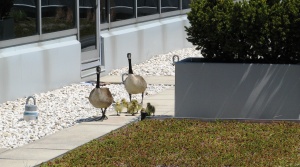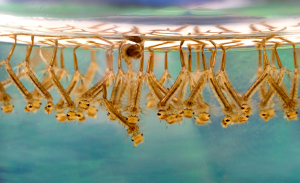Difference between revisions of "Wildlife"
Jenny Hill (talk | contribs) |
Kyle menken (talk | contribs) m (→Geese) |
||
| (31 intermediate revisions by 2 users not shown) | |||
| Line 1: | Line 1: | ||
| − | + | LID practices are not designed to function as, or replace, natural wildlife habitat. In many cases however, wildlife will be likely attracted LID practices and this can have implications on the vegetated components of the feature and their function. Landscaping with native species can have a positive effect on wildlife as well. Native plant species have co-evolved with the local insects, butterflies, birds and other wildlife and provide resources, especially in urban areas where natural habitat is scarce. | |
| − | + | ||
| − | + | ==Geese== | |
| − | + | [[File:Geese.jpg|thumb|Geese raising their young on an extensive green roof, Toronto, ON]] | |
| + | Canada Geese and Cackling Geese can cause damage by eating vegetation, and mess by leaving droppings. In some urban settings they can pose a further nuisance by alarming members of the public. | ||
They are often associated with stormwater management ponds. As many forms of LID reduce or eliminate standing water, the habitat for geese is reduced. | They are often associated with stormwater management ponds. As many forms of LID reduce or eliminate standing water, the habitat for geese is reduced. | ||
| − | However, geese have even been found nesting on extensive green roofs in our region. <br>Here are some tips on control: | + | However, geese have even been found nesting on extensive green roofs in our region. <br>Here are some tips on control: |
| − | + | #Discourage the feeding of any wildlife: This may require public education with signage. | |
| − | + | #Discourage geese from taking off and landing: Geese require open space which can be broken up with fencing or vegetation barriers such as hedges, | |
| − | + | #Mow less frequently: Geese prefer to eat the shorter, younger shoots of turf grass. Reducing mowing lowers maintenance costs and increases roughness (Manning's 'n') for [[vegetated filter strips]] and [[enhanced grass swales]]. Increased roughness slows flow, allowing more water to infiltrate into the soil. | |
| − | + | #Bird deterrent tape: Geese are slightly discouraged by shiny/flickering/reflective movement. Foil tape or flags are available for this purpose. This can be a useful strategy on recently seeded areas or on green roofs, in the late winter, at the start of nesting seaso | |
| − | |||
| − | |||
| − | |||
| − | |||
| − | |||
| − | |||
| − | |||
| − | |||
| − | |||
| − | |||
| − | |||
| − | |||
| − | |||
| − | |||
| − | |||
| − | |||
| − | |||
| − | |||
| − | |||
| − | |||
| − | |||
| − | |||
| − | |||
| − | |||
| − | |||
| − | |||
| − | |||
| − | |||
| − | |||
| − | |||
| − | |||
| − | |||
| − | |||
| − | |||
| − | |||
| − | |||
| − | |||
| − | |||
| − | |||
| − | |||
| − | |||
| − | |||
| − | |||
| − | |||
| − | |||
| − | |||
| − | |||
| − | |||
| − | |||
| − | |||
| − | |||
| − | |||
| − | |||
| − | |||
| − | |||
| − | |||
| − | === | + | ==Mosquitoes== |
| − | + | [[File:Culex.png|thumb|Mosquito larvae developing in water <br>[https://commons.wikimedia.org/w/index.php?curid=1441809 Image: James Gathany, CDC]]] | |
| + | Mosquitoes are a vector for many global diseases. In Ontario they are associated with transmission of West Nile Virus[https://www.publichealthontario.ca/en/DataAndAnalytics/Pages/WNV.aspx]. Low impact development technologies reduce the amount of standing water compared to traditional stormwater ponds as most water is stored in voids within soil and gravel layers. The maximum recommended surface ponding time is 24 hours after a storm event, as this is less than the time required for one mosquito breeding cycle. In some high density urban landscapes, it may be desirable to have a shorter ponding time. | ||
| + | Where designs do include standing water (e.g. in [[Rainwater Harvesting|rainwater harvesting]]), the following practices can reduce mosquito habitat further: | ||
| + | *Mesh is the first line of defense: A mesh size of 1.5 mm or smaller is recommended where a screen is used to exclude mosquitoes from a tank or other standing water[http://www.who.int/ith/2017-ith-chapter7.pdf?ua=1], | ||
| + | *The Ministry of the Envionment and Climate Change permit just two larvicides to be used to kill mosquito larvae growing in the water[http://www.omafra.gov.on.ca/english/livestock/horses/facts/info_mosq.htm#larvicides]: | ||
| + | #Bacillus thuringiensis israeliensis (Bti):Note that provincial regulations permit only granular application, rather than 'dunks' or 'pucks' available elsewhere. This means frequent application may be necessary(Note: Bti has limited efficacy in water bodies with high organic and silt content)[https://www.ontario.ca/page/permit-applicant-guide-private-land-controlling-mosquito-larvae-prevention#section-1] | ||
| + | #Methoprene: This product can only be used by licensed individuals as it is slightly toxic to some fish species. | ||
| + | *Mineral oil or liquid soap: A small quantity of either one of these will disrupt mosquito larvae at the surface of the water. This can be effective in residential [[rain barrels]], but requires regular application. | ||
| + | Airborne adulticides for mosquito control are permitted for use in Ontario. But their use is not recommended for most forms of stormwater control. Encouraging populations of bats, birds, dragonflies and other natural predators is worthwhile for improving biodiversity. But this has not been demonstrated as an effective means of mosquito control. | ||
| − | + | ==Mammals== | |
| − | + | Plantings of young seedlings and saplings are palatable for small mammals and deer. Effective strategies for protecting an LID feature from herbivory by larger mammals may include creating enclosures with fencing. Small mammals such as squirrels, mice or voles will not be deterred by fencing, but planted stock can be protected through the use of rodent guards. | |
| − | + | ==See Also== | |
| − | |||
| − | |||
| − | |||
| − | |||
| − | |||
| − | |||
| − | |||
| − | |||
| − | |||
| − | |||
| − | |||
| − | |||
| − | |||
| − | |||
| − | |||
| − | |||
| − | |||
| − | |||
| − | |||
| − | |||
Latest revision as of 19:18, 15 January 2019
LID practices are not designed to function as, or replace, natural wildlife habitat. In many cases however, wildlife will be likely attracted LID practices and this can have implications on the vegetated components of the feature and their function. Landscaping with native species can have a positive effect on wildlife as well. Native plant species have co-evolved with the local insects, butterflies, birds and other wildlife and provide resources, especially in urban areas where natural habitat is scarce.
Geese[edit]
Canada Geese and Cackling Geese can cause damage by eating vegetation, and mess by leaving droppings. In some urban settings they can pose a further nuisance by alarming members of the public.
They are often associated with stormwater management ponds. As many forms of LID reduce or eliminate standing water, the habitat for geese is reduced.
However, geese have even been found nesting on extensive green roofs in our region.
Here are some tips on control:
- Discourage the feeding of any wildlife: This may require public education with signage.
- Discourage geese from taking off and landing: Geese require open space which can be broken up with fencing or vegetation barriers such as hedges,
- Mow less frequently: Geese prefer to eat the shorter, younger shoots of turf grass. Reducing mowing lowers maintenance costs and increases roughness (Manning's 'n') for vegetated filter strips and enhanced grass swales. Increased roughness slows flow, allowing more water to infiltrate into the soil.
- Bird deterrent tape: Geese are slightly discouraged by shiny/flickering/reflective movement. Foil tape or flags are available for this purpose. This can be a useful strategy on recently seeded areas or on green roofs, in the late winter, at the start of nesting seaso
Mosquitoes[edit]
Mosquitoes are a vector for many global diseases. In Ontario they are associated with transmission of West Nile Virus[1]. Low impact development technologies reduce the amount of standing water compared to traditional stormwater ponds as most water is stored in voids within soil and gravel layers. The maximum recommended surface ponding time is 24 hours after a storm event, as this is less than the time required for one mosquito breeding cycle. In some high density urban landscapes, it may be desirable to have a shorter ponding time. Where designs do include standing water (e.g. in rainwater harvesting), the following practices can reduce mosquito habitat further:
- Mesh is the first line of defense: A mesh size of 1.5 mm or smaller is recommended where a screen is used to exclude mosquitoes from a tank or other standing water[2],
- The Ministry of the Envionment and Climate Change permit just two larvicides to be used to kill mosquito larvae growing in the water[3]:
- Bacillus thuringiensis israeliensis (Bti):Note that provincial regulations permit only granular application, rather than 'dunks' or 'pucks' available elsewhere. This means frequent application may be necessary(Note: Bti has limited efficacy in water bodies with high organic and silt content)[4]
- Methoprene: This product can only be used by licensed individuals as it is slightly toxic to some fish species.
- Mineral oil or liquid soap: A small quantity of either one of these will disrupt mosquito larvae at the surface of the water. This can be effective in residential rain barrels, but requires regular application.
Airborne adulticides for mosquito control are permitted for use in Ontario. But their use is not recommended for most forms of stormwater control. Encouraging populations of bats, birds, dragonflies and other natural predators is worthwhile for improving biodiversity. But this has not been demonstrated as an effective means of mosquito control.
Mammals[edit]
Plantings of young seedlings and saplings are palatable for small mammals and deer. Effective strategies for protecting an LID feature from herbivory by larger mammals may include creating enclosures with fencing. Small mammals such as squirrels, mice or voles will not be deterred by fencing, but planted stock can be protected through the use of rodent guards.

